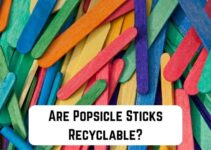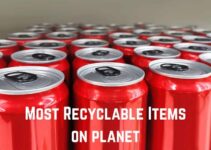If you happen to have a kitchen, one thing is for sure, you have to clean your utensils. You either do it manually or mechanically by using a dishwasher. With that, you have to go for the best and most people tend to go for Tide, the laundry detergent brand.
Tide is owned and manufactured by Proctor & Gamble, an American company that specializes in a wide range of personal health or consumer health, and personal care and hygiene products. Tide is beloved and has 14.3% of the global laundry care market versus Omo’s 5.2%. With that said, how does it fare versus the environment? This article understands Tide’s role in the environment.
Are Tide Pods Bad For the Environment?
Tide pods are not good for the environment. Well, the active ingredients in Tide pods are biodegradable, meaning that only the cleaning ingredients are biodegradable. However, there are other ingredients in Tide pods that are not biodegradable.
Additionally, they are not recyclable and can only be used and disposed of through the plumbing system. This means that they will not be okay for the environment in the long run.
In general, detergent pods, packs or liquitabs, are water-soluble pouches of ultra-concentrated laundry detergent. They contain around 10% water compared with 50% water or higher in liquid detergents.
They are designed to eliminate the need for measuring out liquid detergent or powders; you only need to throw the pod into your washing machine.
What makes them harmful to the environment is that they contain a very damaging chemical cocktail. The impact of the chemicals last well beyond your wash cycle and are therefore detrimental to the environment, you and your family. Brands such as Tide use a high number of these chemicals, some of which they do not disclose.
However, for those they disclose, five of them are concerning. First, you have phosphates, which are particularly damaging to the marine environment when dispersed in wastewater from your wash. They create algae blooms that starve marine flora and fauna of oxygen.
Secondly, they include formaldehyde, a chemical usually associated with the preservation of dead bodies. It is an ingredient classified by the EPA as a class B1 probable carcinogen, meaning it is linked with an increased risk of cancer and in the marine biome, reproductive impairment.
Thirdly, you have 1,4 Dioxane which is probably one of the worst additives. Dioxane is another carcinogen that poses a serious combustion risk. Exposure in marine environments impairs the central nervous system, eyes, and skin or scales of marine animals.
Fourthly, we have bleach, often used to brighten whites. Its fumes cause respiratory distress and contact with skin and eyes, it can cause caustic burns, both in human and marine life. Finally, we have ammonium sulfate and ammonium quaternary sanitizers, which are harsh and corrosive cleaning agents.
They are known to cause eye, skin, and lung damage even with minimal exposure to both human and marine life. More to these chemicals, detergent pods are responsible for the growing number of household poisonings, given that thousands of children will eat them without knowing.
This is major because of their heavy fragrance and bright colors, which makes the pods look deceptively like a delicious sweet to enjoy.
Are Tide Pods Biodegradable?
In general, No. Tide pods are not biodegradable. Well, their active ingredients in Tide are biodegradable, meaning that only the cleaning ingredients are biodegradable. However, the remaining ingredients are completely not biodegradable.
The biggest problem arising from this is that they contain chemicals, harmful chemicals. Well, the pods can decompose, but it also means that the chemicals will leech into the soil, poisoning the plants and the soil in general.
This also means that you should not compost Tide pods, for the fear of poisoning your compost which will, in turn, do the same to the soil and plants. It also means that the chemicals might affect the helpful microorganisms that aid in the composting process, halting the entire process altogether.
Tide pods are known to contain at least the five ingredients listed above, known to be bad for the environment. They are phosphates, bleach, formaldehyde, dioxanes, and ammonium sulfate and ammonium quaternary sanitizers.
They are particularly harmful to the marine environment, affecting both the water and marine animals. They will further affect human life because of their toxicity, and poison children who are fond of eating or licking anything that has heavy fragrances and bright colors, like Tide pods.
Granted, the detergent in Tide Pods contains only 10% water and less water means they are lighter and much more efficient to ship, which dials back their carbon footprint. Additionally, they gave the potential to reduce packaging waste.
However, their effects on the environment far outway these merits. The only environmentally healthier alternatives include laundry detergent sheets, soap nuts or soapberries, Dropps eco pods or Dr Bronners Castile soap.
How Do Tide Pods Affect the Environment?
1. The outer packaging
The outer packaging in Tide Pods is made from a water-soluble polymer, polyvinyl alcohol. The polymer is technically safe, although it can break down into a toxic monomer called vinyl acetate. The toxic monomer is known to harm aquatic lifeforms and cause tumors in rats.
It is for this reason that all conventional detergents have a warning on them saying, “Harmful to aquatic life, with long-lasting effects”. Moreover, the hard plastic box that the sachets come in is seldom recyclable.
In addition, even if the coating breaks down, it does not truly dissolve until the right microbes are introduced, and they are only found in a water treatment plant. As such, if you are not on city sewer, these products will leave behind traces of chemicals other than carbon dioxide and water.
2. The chemical composition
As already established, pods contain a very damaging chemical cocktail, which is not only damaging to the environment but also you and your family. Its impacts last well beyond your wash cycle and unfortunately for Tide, they do not disclose all the ingredients they use to make their pods.
However, for the known ones, we know them to be extremely damaging to the environment as well as human and marine life. For instance, the phosphates that will be dispersed in wastewater from your wash will create algae blooms that starve marine flora and fauna of oxygen.
They also contain formaldehyde, a chemical usually associated with the preservation of dead bodies, and have been classified by the EPA, as a class B1 probable carcinogen. The bleach, 1,4 Dioxane and ammonium sulfate and ammonium quaternary sanitizers can bring about respiratory distress, impair the central nervous system and affect eyes, skin and scales, both in humans and marine animals.
3. They are deceptive
Well, this is not an effect on the environment, but wait for it! individual pods and sachets are conveniently made to eliminate the tendency to over-dose. Unfortunately, they cannot be used neat to pre-treat stains, and the dosage cannot be adapted to suit the size and dirtiness of your laundry load.
Remember they were made as a way of extracting more money from the same product, meaning you will be paying more for a ‘convenient’ product, which is the same as the original, and will not be sufficient. This will, therefore, force you to use more pods, injecting more chemicals into the environment, yet the powdered version might have been more effective and less damaging to the environment.
Moreover, they have bright colours and deceive children that they are sweets. This is why in the one year between 2012 and 2013, the American Association of Poison Control Centers reported over 7,000 cases of young children eating laundry pods and 10,570 cases in 2017.
Between 2012 when they hit the market and mid-2017, the Consumer Product Safety Commission (CPSC) reported eight deaths related to laundry detergent pod ingestion
Are Dishwasher Pods Bad For the Environment?
Dishwasher pods are bad for the environment! There are no two ways around this, and they will be doing more harm than good. The deceptive part which makes one campaign for the dishwasher pods is the outer packaging. It is made from polyvinyl alcohol (PVA), which is a water-soluble, shelf-stable, and synthetic polymer.
Being water-soluble means it will dissolve when it is in contact with water, making it more preferable. They are small and already come in dosages, leaving you free to store them anywhere and not have to estimate measurements. The ideal detergent pod should dissolve in both cold and hot water, leaving no material that might clog pipes.
Unfortunately, there is more to this. First, not all dishwasher pods are environmentally friendly. They will therefore harm the environment while they claim to help you clean your dishes.
Secondly, PVA is only as irritating as the dish detergent held inside, requiring light washing and flushing with cold water if you get it on your skin or in your eyes.
Thirdly, we have determined that they can be easily swallowed by children, resulting in poisoning and worse, deaths. How is it a safe product if it can result in deaths?
Finally and most importantly, it is packed full of nasty ingredients from toxic surfactants to hormone-addling fragrances. They include, among others, phosphates, formaldehyde, bleach, 1,4 Dioxane and ammonium sulfate and ammonium quaternary sanitizers, all of which are harmful to the environment and humans and marine life. And these are the only ingredients known as of now since most companies do not release all the information regarding the same.
Which of These is Better: Pods or Liquid Detergent?
Overwhelmingly, liquid detergents are better than pods. Liquid detergents are a popular choice since they double as stain-removers and can work on grease, and are less expensive than pods.
Pods, on the other hand, are pre-measured doses of detergent combined with a stain-fighting liquid and fabric brightener. Their only advantage over liquid detergent is that they are convenient and easier to manage than the huge jugs of detergent since they are pre-measured.
However, they are more expensive and are becoming increasingly dangerous to have around the house, given that their colorful exterior looks like candy. In addition to the children who have suffered injuries and died from swallowing pods, NBC News reports that two children and six adults with cognitive impairment died between 2012 and 2017 as a result of ingesting the pods.
From an environmental perspective, pods are harmful to the environment, making them worse. Their outer packaging, advertised as recyclable, is seldom recyclable. They are not good at treating spot stains and require their overuse for them to achieve the same.
They also, cannot be adjusted for small loads or handwashing single items, making them inconvenient. Additionally, they are made using dangerous chemicals, the majority of which are determined to have adverse effects on human and marine life.
As regards liquid detergents, their packaging is recyclable and more environmentally friendly, is cheaper, and can be adjusted for small or single hand wash, as well as heavy loads. They are also more stable than pods, making them ideal for stain pre-treatment or spot cleaning.
References:
https://tide.com/en-us/our-commitment/sustainability/saving-energy
https://www.nbcnews.com/business/consumer/laundry-pods-can-be-fatal-adults-dementia-n773366






